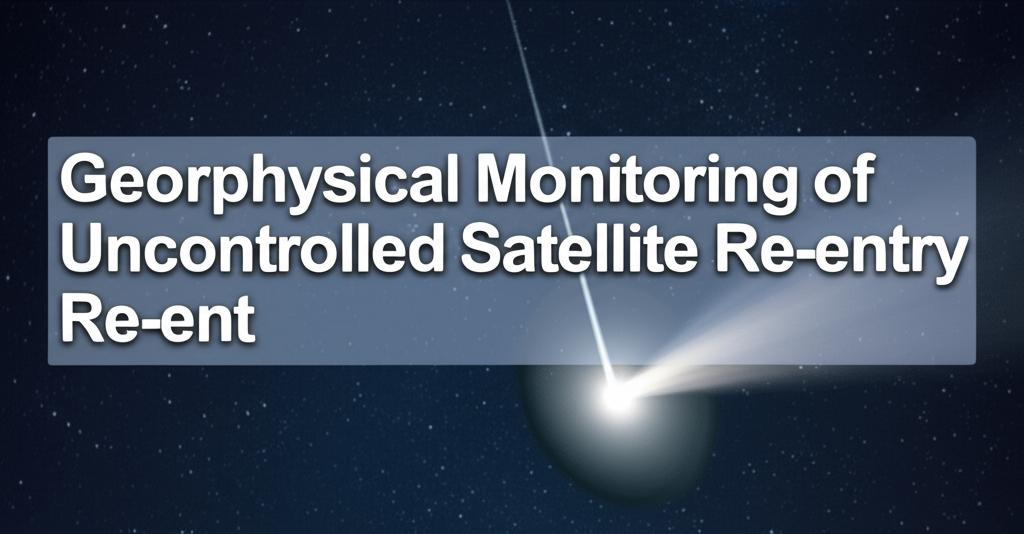The uncontrolled re-entry of satellites and other space objects into Earth's atmosphere presents a growing concern that necessitates sophisticated geophysical monitoring techniques. As the number of objects in orbit increases, so does the likelihood of uncontrolled descents, where the precise time and location of re-entry are difficult to predict. This unpredictability poses risks, albeit small, to people and infrastructure on the ground.
Current Monitoring Approaches and Technologies:Several space agencies and research institutions, including NASA, ESA, and CNES, have developed tools and methods to predict and analyze the re-entry of space objects. These tools, such as NASA's ORSAT and DAS, ESA's SCARAB and DRAMA, and CNES's STELA, focus on several key areas:
- Cataloging and Databases: Maintaining comprehensive databases of space objects and their re-entry events.
- Lifetime and Trajectory Predictions: Estimating how long an object will remain in orbit and its likely re-entry path.
- Break-up Modeling: Simulating how a spacecraft will disintegrate upon re-entry and predicting the distribution of surviving debris.
- Ground Impact Probability: Assessing the likelihood of debris impacting populated areas.
These predictions rely on various data inputs, including orbital parameters, atmospheric models, and the physical characteristics of the re-entering object. However, uncertainties in atmospheric conditions, solar activity, and the object's orientation and material properties make precise predictions challenging. Typically, even days before re-entry, the uncertainty window for the impact time can be several hours, translating to thousands of kilometers in potential impact location.
Advancements in Geophysical Monitoring:A promising and relatively new approach involves the use of seismometers to detect and track the atmospheric shock waves (sonic booms) generated by re-entering space debris.
- Sonic Boom Detection: As an object travels at hypersonic speeds through the atmosphere, it creates shock waves that can be detected by sensitive ground-based seismometers.
- Trajectory Reconstruction: By analyzing the arrival times and characteristics of these seismic signals at multiple stations, scientists can reconstruct the trajectory of the debris through the atmosphere. This technique has been successfully demonstrated, for instance, with the re-entry of a Chinese Shenzhou-15 spacecraft module over California in April 2024. Seismometers stationed throughout the Los Angeles basin picked up the sonic booms, allowing a team to reconstruct the spacecraft's path.
- Complementary to Traditional Methods: This seismic method can complement existing radar and optical tracking systems, especially in remote or unpopulated areas where traditional sensor coverage is limited. Seismometers are particularly adept at picking up minute vibrations from sonic booms.
Despite these advancements, several challenges remain:
- Atmospheric Variability: The Earth's atmosphere is constantly changing, with fluctuating winds and weather conditions affecting how sound and shock waves propagate. This variability can impact the precision of trajectory reconstruction using seismic data.
- Object Characteristics: The size, shape, and fragmentation behavior of re-entering objects are often not precisely known, adding to prediction uncertainties.
- Data Integration and Speed: For seismic detection to be effective in hazard mitigation, data from seismometer networks needs to be processed and analyzed rapidly to provide timely warnings if debris is predicted to impact populated areas.
- Communication Blackouts: During re-entry, the intense heat generated can create a plasma sheath around the object, leading to a "blackout zone" where communication with the object is lost. This limits the ability to receive real-time data from on-board sensors during the critical final stages of descent.
- Distinguishing Natural from Artificial Events: Seismic and infrasound signals from re-entering debris need to be distinguished from natural events like meteors or terrestrial explosions.
Hundreds of tracked objects re-enter Earth's atmosphere annually, with a significant portion being uncontrolled. While the risk to any single individual remains extremely low (considerably lower than being struck by lightning), the overall risk to the global population and critical infrastructure increases with the growing number of satellites and space activities. Events like the re-entry of Skylab (1979), Salyut-7/Kosmos-1686 (1991), and more recently, ESA's ERS-2 satellite (February 2024) highlight the importance of monitoring and prediction.
Future Directions:Future efforts in geophysical monitoring of uncontrolled satellite re-entries will likely focus on:
- Improved Atmospheric Models: Enhancing the accuracy of atmospheric models to better predict shock wave propagation.
- Sensor Network Expansion and Integration: Expanding global seismometer and infrasound sensor networks and improving data sharing and integration for a more comprehensive global monitoring capability.
- Machine Learning and AI: Utilizing machine learning algorithms to improve prediction accuracy by analyzing vast amounts of tracking data and identifying patterns in re-entry events and debris fragmentation.
- On-board Monitoring Systems: Developing advanced sensors and data transmission technologies for CubeSats and other small satellites to gather crucial data on fragmentation and atmospheric conditions during re-entry, helping to validate and improve re-entry analysis tools.
- International Cooperation: Strengthening international collaboration in data sharing, research, and the development of common standards and procedures for monitoring and mitigating risks from uncontrolled re-entries. The Inter-Agency Space Debris Coordination Committee (IADC) already plays a vital role in this area.
In conclusion, geophysical monitoring of uncontrolled satellite re-entries is a dynamic and evolving field. While traditional methods provide a foundational understanding, innovative techniques like seismic tracking offer new avenues for improving detection and trajectory analysis. Addressing the inherent uncertainties and enhancing international cooperation will be crucial in managing the risks associated with the increasing population of objects returning to Earth from space.

